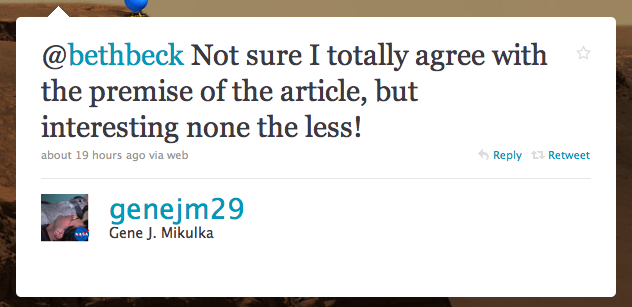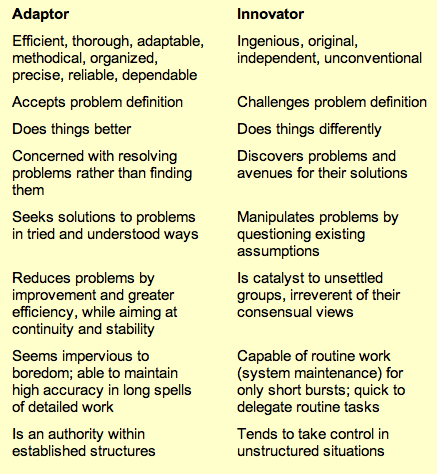Anke Domscheit-Berg ignited a gender fire storm yesterday with her GovLoop blogpost: “Why do women understand government 2.0 and social media better than men?”
My good buddy and LAUNCH: Health teammate, Todd Khozein, sent me an email yesterday with the link. I read the post and left a comment, then tweeted out the link. I received these comments back:
Interesting conversation about whether women are better suited to embrace Gov 2.0 tools. Personally, I love social media tools, but I work with women who don’t. I’ve learned a great deal about Gov 2.0 from incredibly gifted progressive guys at NASA, but watched many more snub their noses at it. I think it goes both ways.
Though gender may give insight into how men and women approach situations differently, we may find a less contentious Gov 2.0 cheerleader-meter.
The Kirton Adaptation-Innovation Inventory may just be the PERFECT tool to flush out change agents.
The Kirton Inventory measures problem-solving and creativity in individuals and helps teams understand the different ways they approach solutions. I first learned of the Kirton Inventory back in the 1990s when I planned an off-site retreat for the Office of Policy and Plans (better known as the Land of MisFit Toys) led by Lori Garver. We brought in a facilitator who tested us, then walked us through how our Kirton scores would help Lori make smart team assignments.
The Kirton Inventory scores individuals on a continuum from Adaptors to Innovators. The Adaptors work best within the existing system, seeing change as a matter of tweaking and perfecting what already exists. The Innovators embrace all things new and adapt quickly to change.
At the extreme ends of either side of the spectrum, the Adaptors find comfort in the status quo where the Innovators prefer tossing out the old and starting fresh. Neither side can speak the language of the other, and need translators — who are the individuals who scored somewhere in the middle of the spectrum. These individuals are called the “Bridge” because they can speak both languages: status quo and change.
Our facilitator advised that every team needed at least one Bridge to keep the process moving, otherwise miscommunication and misunderstandings could impede progress.
My Kirton Inventory scores qualified me as an extreme innovator. Most of my workmates scored on the opposite end of the spectrum as Adaptors, and some as extreme Adaptors. I began to understand for the first time why I felt like an alien at NASA. My Innovator-DNA hadn’t equipped me to relate, understand, or communicate with “the Adaptors.”
According to an article about the Kirton Inventory Tool in “Chemical Innovation: Can corporate innovation champions survive?” Nov 2001…
Extreme Innovators describe Extreme Adaptors as:
- dogmatic,
- compliant,
- stuck in a rut,
- timid,
- conforming, and
- inflexible.
Extreme Adaptors describe Extreme Innovators as:
- Unsound
- impractical,
- abrasive,
- undisciplined
- insensitive,
- one who loves to create confusion.
I’ve heard many of these words used to describe me — abrasive, impractical, chaos-creator. Yep, the story of my 25 years at NASA.
Back to the original question: Does an affinity for change (think Gov 2.0) have anything to do with gender, as described in Anke’s thought-provoking blogpost? Are Innovators or Adaptors pushed to the extremes through influences or factors linked to DNA, socialization, gender, or experiences? The Kirton Inventory doesn’t address the causes behind the scores, so I can’t answer the question. I can only offer another data point for the discussion.
I have an idea! Why don’t you take the Kirton test yourself? See if you’re an Adaptor or Innovator. Let me know what you find out.
But if you’re an Adaptor, remember to bring your translator with you. Otherwise, I might not understand a word you say.
Crosspost on Beth Beck’s Blog.










Thank you for the test and the interesting post. I suppose my biggest objection to determining if a person has certain traits and labeling that package of traits is that people tend to use this as an excuse to not leave their comfort zone. The brain is remarkably plastic and as research has shown people can radically their personality due to injury or illness.
You say you are an innovator but you probably also have adaptive tendencies when the situation calls for those traits. You’ve also lasted 25 years at NASA so you must have learned to adapt to other personalities and can communicate with people effectively so you’ve learned to see things from another perspective.
It’s good to know your strengths but it is also good to leave your comfort zone and try new perspectives. Diversity is the beginning of innovation and is desperately needed in our organizations.
Life is all about adaptation. Some adapt more quickly than others to new situations or changes in environment. The Kirton Inventory simply measures the comfort zone from “status quo” to “start over.” When change happens, some embrace it more readily than others.
I prefer to start new projects where I get to create the process from scratch. I’ve worked many jobs (procurement, budget, etc) where my sole purpose in life was to follow the rules and restrict any deviation from the tried and true. I can do these jobs, but I don’t thrive in a highly structured environment. Some of my colleagues, however, enjoy jobs where tradition dictates future decisions. I appreciate tradition, but I don’t feel bound by it. I gravitate to projects that no one knows how to handle, or no one “wants” to touch.
Tools like the Kirton Inventory and Myers-Briggs simply help us understand how others approach work/life, which should never be an excuse for poor behavior, but can be data points leading to a solution.
In public service, the end goal is creating and upholding the public good. We (Adaptors & Innovators, Male & Female, Young & Old, Colorful & Colorless) may approach it differently, but if we get there in the end, then all is well with the world. 🙂
@Beth: Thanks for posting. My own personal bias is to use hard data in the form of assessments and inventories like the MBTI and the Kirton Inventory as a baseline. For those SJ types especially, since they tend to fill the upper-level management and leader ranks in organizations from corporations to the military, showing them the data for how and why they process information and make decisions leads to better self-awareness and group awareness.
@Bill: Please don’t think I’m picking on you. I’ve noticed in your postings that you tend to not like labels for people. That characteristic is typical of Generation X, which is another label and generalization, just one that might be slightly true. 😉
@Michele: Astute observation. 🙂 Another characteristic of Generation X is skepticism which I also claim. My background is in communication with a specialization in persuasion and propaganda with a Masters in political management (an applied form of political communication). Labels can be very powerful tools especially in the political sphere.
Just this week in my political communication class, I was discussing with the students how to use the generic label of “the Other” to vilify the opposition and to build group cohesiveness. A couple of weeks ago, I discussed how to use labels (such as “Soccer Moms”) to create self-fulfilling prophecies for select voting groups.
Labels are very powerful tools and we have to be careful how we use them.
Thx @Bill + @Michele for the discussion.
Comment: Any “label” used as a weapon to belittle or marginalize or self-promote is emotional (political) propaganda. Labels can be bad if used against, and instructive if used to supply information. I’m a Texan. Some will use that label against me. Personally, I’m proud of it. I’m a boot-straps kinda guy (generic term). I’m also a bureaucrat, by label. Most cringe at the term. But I actually work for a bureaucracy, so it’s true. I think the point is to learn more about each other so that we can get the work done as efficiently as possible.
No label will get the work done. People do. 😉